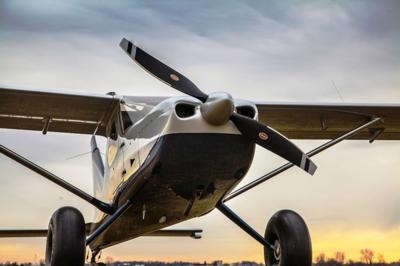Tue, Mar 18, 2014
Two- And Three-Blade Versions 'Designed To Maximize Performance' Company Says
Hartzell Propeller is introducing two- and three-blade versions of its new swept-tip Trailblazer prop for experimental aircraft and a number of certificated aircraft models.

“I put the new Hartzell Trailblazer prop on my Sportsman for increased performance that backcountry flying demands. Backcountry flying is all about getting into remote landing areas, but once you’re in you have to get back out,” said Hartzell Propeller President Joe Brown. “The takeoff acceleration and climb performance of the new Trailblazer prop gives me the added performance I want for backcountry flying.”
The new Hartzell Trailblazer swept-tip propellers are designed to maximize performance of the numerous aircraft, both certified and amateur built, specifically designed for bush and backcountry flying. The two-blade version is compatible with most Lycoming 360 and 390 series engines, with no placards or restrictions. A three-blade version is available for higher horsepower applications. In addition, Hartzell Propeller is working with numerous aircraft manufacturers to pursue approvals to install the new Trailblazer propeller on certified aircraft.
The two-blade configuration of the Hartzell Trailblazer propeller is available in 78”, 80” and 83” diameters and the three-blade configuration in 80”, 82” and 85” diameters. All have unlimited blade life and are approximately 20 percent lighter than comparable propellers with aluminum blades. The swept-tip, scimitar shaped airfoil is designed for optimal take-off acceleration and climb performance, resulting in an increase of 80-100 fpm climb rate versus a three-blade wood core propeller. The thin, stiff airfoil design that is possible when utilizing aerospace composites allows improved low speed thrust while achieving a three-knot cruise speed improvement over wood core props.
The Hartzell Trailblazer’s all carbon fiber construction features an innovative mesh erosion shield and field replaceable nickel-cobalt leading edge ensuring it can withstand demanding backcountry and bush flying. The carbon fiber structural composite construction is more than five to 10 times stronger than beech wood and spruce, respectively, and includes Hartzell’s state-of-art wedge shank blade retention design.
(Image provided by Hartzell)
More News
Aero Linx: International Federation of Airworthiness (IFA) We aim to be the most internationally respected independent authority on the subject of Airworthiness. IFA uniquely combi>[...]
Ultrahigh Frequency (UHF) The frequency band between 300 and 3,000 MHz. The bank of radio frequencies used for military air/ground voice communications. In some instances this may >[...]
A Few Questions AND Answers To Help You Get MORE Out of ANN! 1) I forgot my password. How do I find it? 1) Easy... click here and give us your e-mail address--we'll send it to you >[...]
From 2019 (YouTube Edition): Learning To Paint Without Getting Any On Your Hands PPG's Aerospace Coatings Academy is a tool designed to teach everything one needs to know about all>[...]
Also: Sustainable Aircraft Test Put Aside, More Falcon 9 Ops, Wyoming ANG Rescue, Oreo Cookie Into Orbit Joby Aviation has reason to celebrate, recently completing its first full t>[...]
 ANN's Daily Aero-Linx (05.06.25)
ANN's Daily Aero-Linx (05.06.25) ANN's Daily Aero-Term (05.06.25): Ultrahigh Frequency (UHF)
ANN's Daily Aero-Term (05.06.25): Ultrahigh Frequency (UHF) ANN FAQ: Q&A 101
ANN FAQ: Q&A 101 Classic Aero-TV: Virtual Reality Painting--PPG Leverages Technology for Training
Classic Aero-TV: Virtual Reality Painting--PPG Leverages Technology for Training Airborne 05.02.25: Joby Crewed Milestone, Diamond Club, Canadian Pilot Insurance
Airborne 05.02.25: Joby Crewed Milestone, Diamond Club, Canadian Pilot Insurance



